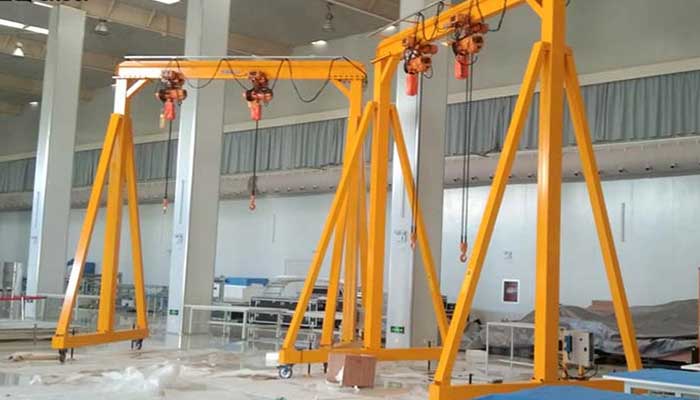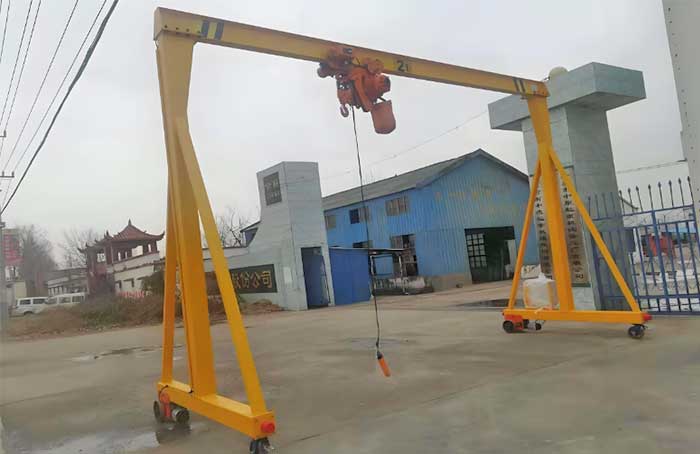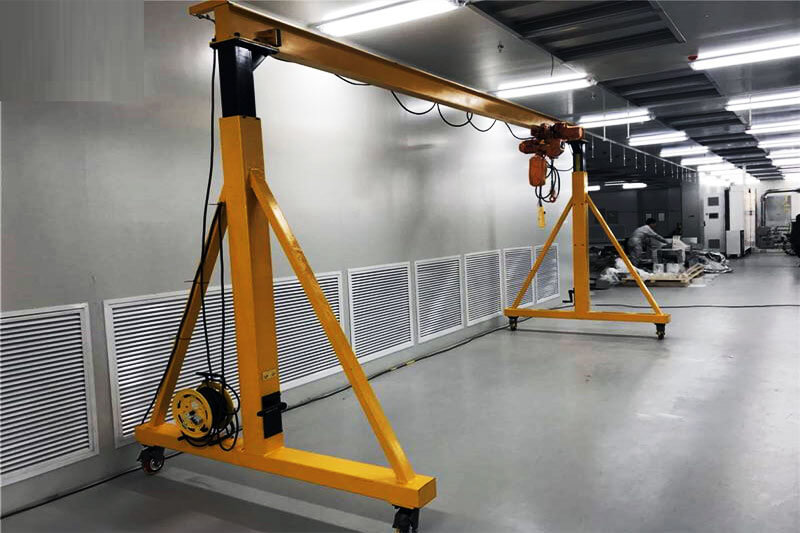Small Portable Gantry Cranes- Select Best Portable Indoor Crane
Portable indoor crane for sale. Small portable gantry cranes for indoor tasks: versatile, & budget-friendly choices for effortless lifting solutions.
Overview of Small Portable Gantry Cranes
A small portable gantry crane is a versatile and lightweight lifting device designed primarily for indoor use, with occasional applications outdoors. Its core components include the bridge, which is the horizontal beam that spans the crane’s width, the supporting legs that elevate and stabilize the crane, and the hoist system responsible for lifting and lowering loads.
These cranes are valued for their ability to provide stability and support in various settings, particularly where space is at a premium and mobility is essential. The compact design of small portable gantry cranes makes them particularly effective in environments like workshops and warehouses. In these spaces, their small footprint and maneuverability enable them to handle lifting tasks efficiently, even in tight or cluttered areas.
Key Features of Small Portable Gantry Cranes
Design and Construction
Material Options
Small portable gantry cranes are constructed from a variety of materials, each selected to balance weight, strength, and cost. Aluminum is commonly used for its lightweight properties, making cranes easier to transport and maneuver. It is ideal for applications requiring frequent relocation. Steel, on the other hand, is favored for its durability and strength, providing robust support for heavier loads and more demanding environments.
Adjustable Features
One of the standout features of these cranes is their adjustability. Many models offer the ability to modify both height and width, allowing users to tailor the crane to different lifting tasks and load sizes. This flexibility is crucial for handling various types of loads efficiently. Additionally, stability and mobility are enhanced through components like wheels and locking mechanisms. Wheels, often found on portable gantry cranes, facilitate easy movement across surfaces, while locking mechanisms ensure stability during operation by securing the crane in place.
Capacity and Load Handling
Weight Capacities
Small portable gantry cranes come with a range of weight capacities to suit different lifting needs. Typically, these capacities range from 0.25 tons to 10 tons. The choice of crane depends on the specific requirements of the task at hand. For lighter tasks, such as handling small components or equipment, lower-capacity models are sufficient. For heavier loads, such as larger machinery or bulk materials, higher-capacity cranes are necessary.
Load Types
These cranes are designed to handle a diverse range of loads. From bulk items like materials and parts to delicate equipment requiring careful handling, the versatility of small portable gantry cranes makes them suitable for various applications. Whether lifting heavy construction materials or precise components in a laboratory setting, these cranes are adaptable to the load types they encounter.
Portability and Maneuverability
Mobility Features
The mobility of small portable gantry cranes is significantly influenced by their wheels or casters. Different types of wheels are designed to handle different surfaces and weights. For instance, larger wheels or casters may be used to navigate rough terrain, while smaller, swiveling casters might be chosen for smooth indoor floors. The design of these wheels impacts the ease with which the crane can be moved, affecting overall efficiency.
Ease of Setup
Another key feature of these cranes is their ease of assembly and disassembly. Many models are designed to be set up quickly with minimal tools, making them convenient for temporary or mobile applications. This ease of setup is especially valuable in environments where frequent changes in crane location are necessary. Factors such as the complexity of the assembly process and the number of components involved play a role in determining how quickly the crane can be operational.
Applications and Benefits
Indoor Workspaces
Common Settings
Small portable gantry cranes are ideal for a variety of indoor settings, including workshops, warehouses, and maintenance areas. In workshops, they assist with tasks such as assembly and equipment handling. In warehouses, they facilitate the movement of goods and materials. Maintenance areas benefit from these cranes when performing repairs or adjustments on heavy machinery.
Benefits
One of the primary benefits of using small portable gantry cranes in indoor environments is their space-saving advantage. Their compact design allows them to fit into tight areas where traditional cranes might not be practical. Additionally, these cranes offer remarkable flexibility and adaptability, making them suitable for a wide range of tasks. This ability to adjust to different needs and settings enhances their utility in dynamic work environments.
Advantages of Using Small Portable Gantry Cranes
Flexibility
Small portable gantry cranes excel in flexibility, allowing them to be easily moved between different locations or job sites. This mobility makes them particularly useful for projects that require frequent relocation or have varying lifting requirements. Users can set up the crane where it's needed most, improving efficiency and productivity.
Versatility
These cranes are highly versatile and can be employed across various industries and tasks. Whether in manufacturing, construction, or maintenance, their adaptability makes them a valuable tool for lifting and handling diverse types of loads. This versatility ensures that they can meet the specific needs of different applications, from delicate equipment to heavy bulk materials.
Cost-Effectiveness
When compared to fixed cranes, small portable gantry cranes offer significant cost savings. They are generally more affordable both in terms of initial investment and maintenance costs. For businesses and operations with limited budgets, these cranes provide a cost-effective solution without compromising on functionality or performance.
Space Efficiency
The reduced footprint of small portable gantry cranes is another key advantage. Their compact size allows them to operate in confined spaces where larger cranes would be impractical. Additionally, their ability to be disassembled for storage when not in use further enhances their space efficiency, making them ideal for environments with limited storage options.
Selection Criteria
Assessing Your Needs
Load Requirements
Start by evaluating the weight and dimensions of the loads you will be lifting. Small portable gantry cranes come with varying lifting capacities, typically ranging from 0.25 tons to 10 tons. Understanding the maximum load your crane will need to handle ensures you select a model with adequate capacity. Consider not only the weight but also the size and shape of the loads, as this will affect the type of crane and its configuration.
Space Constraints
Next, take into account the layout of your facility. Measure the available space where the crane will be used, including the height, width, and clearance requirements. Small portable gantry cranes offer adjustable height and span options, which can be crucial for fitting into tight spaces or adapting to different tasks. Ensure that the crane’s dimensions and mobility features align with your space constraints to avoid operational challenges.
Frequency of Use
Consider how often you will use the crane and for what types of tasks. If the crane will be used frequently, you might need a model with higher durability and advanced features. Frequent use may justify the investment in an electric mini mobile crane or an adjustable crane with enhanced performance capabilities. For occasional use, a manual portable crane might suffice, offering cost savings and simplicity without sacrificing essential functionality.
Comparing Models and Specifications
Manual Travelling Portable Cranes
Manual portable cranes typically operate using a hand chain or lever system. Constructed from durable steel, these cranes offer a robust solution for lifting needs. They are often chosen for their simplicity and reliability.
Pros:
- Cost-Effectiveness: Manual cranes are generally less expensive than electric or adjustable models.
- Independence from Power Sources: They can be used in locations without electrical power, making them versatile for various settings.
- Simplicity and Low Maintenance: Fewer moving parts mean easier maintenance and lower operational costs.
Cons:
- Physical Demands: Manual operation can be strenuous, especially for heavier loads or frequent use.
- Limited Efficiency: They might not be suitable for high-frequency or continuous operations due to slower lifting speeds and manual effort required.
Electric Travelling Mini Mobile Cranes
Electric mini mobile cranes are powered by electricity, enhancing their lifting capacity and efficiency. These cranes often come with adjustable options for height and span, providing greater versatility and precision in operations.
Pros and Cons:
Pros:
- Enhanced Performance: Electric operation allows for smoother and more efficient lifting, with reduced physical strain on operators.
- Versatility: Adjustable features and power operation make them suitable for various tasks and environments, including both indoor and occasional outdoor use.
Cons:
- Power Supply Dependence: These cranes require access to electricity, which might limit their use in locations without power sources.
- Higher Initial Cost: The cost of electric models is typically higher than manual cranes, reflecting their advanced features and capabilities.
- Maintenance Needs: Regular maintenance is essential to keep the electric components in optimal condition.
Adjustable Portable Cranes
Adjustable portable cranes offer flexibility with adjustable height and span. They can be equipped with either manual or electric hoists, catering to a range of lifting requirements and preferences.

Pros:
- Flexibility: Adjustable features allow these cranes to accommodate various load sizes and shapes, making them versatile for different tasks.
- Mobility and Ease of Use: Despite their adjustable nature, these cranes are designed for easy movement and setup within facilities.
Cons:
- Higher Cost: The added flexibility and adjustable features contribute to a higher price compared to manual cranes.
- Maintenance Requirements: Depending on whether the hoist is manual or electric, maintenance needs can vary, potentially adding to long-term operational costs.
Manufacturer and Supplier Considerations
Choosing Reliable Brands
When selecting a small portable gantry crane, the brand’s experience and reputation play crucial roles. Opt for manufacturers known for their quality and reliability in the industry. Established brands often offer proven track records in both product performance and customer satisfaction. Look for companies with a history of delivering durable, high-performance cranes and those that adhere to industry standards and certifications.
Warranty and Support
Evaluate the warranty and after-sales support offered by the manufacturer. A comprehensive warranty provides reassurance about the crane's longevity and performance. Check for details such as the duration of coverage and what it includes, such as parts and labor. Additionally, robust after-sales support is essential for addressing any issues that arise post-purchase. This includes access to customer service, availability of replacement parts, and technical support.
Customer Reviews
Customer testimonials and reviews offer valuable insights into the real-world performance and reliability of the crane. Look for feedback from other users regarding their experiences with the crane, focusing on aspects like ease of use, durability, and the quality of customer service. Reviews can help identify any potential issues or common concerns that might not be evident from product specifications alone. Positive reviews and high ratings often indicate a product and supplier that are well-regarded in the market.
Maintenance and Care
Routine Maintenance Requirements
Inspection and Upkeep
To ensure your small portable gantry crane operates at its best, regular inspection and upkeep are essential. Conduct routine checks to verify that all components, including the hoist system, wheels, and structural elements, are functioning correctly. Pay attention to any signs of wear or damage that could impact performance or safety. Regular inspections should include verifying the integrity of welds, bolts, and joints, as well as ensuring that all safety mechanisms are in place and working properly.
Cleaning and Lubrication
Maintaining cleanliness and proper lubrication of the crane’s moving parts helps prevent premature wear and extends the life of the equipment. Clean the crane regularly to remove debris, dust, and any substances that could cause corrosion or hinder performance. Apply appropriate lubricants to moving parts such as the hoist system, wheels, and any adjustable components to ensure smooth operation. Follow the manufacturer’s recommendations for cleaning products and lubricants to avoid damaging the crane.
Troubleshooting Common Issues
Identifying Problems
Being aware of common issues and their symptoms can help you address problems before they escalate. Typical problems might include unusual noises, jerky movements, or difficulty in adjusting the crane’s height or span. Other signs of issues could include uneven load distribution or instability during operation. Identifying these problems early can prevent further damage and ensure continued safe use of the crane.
Solutions and Repair Tips
Basic troubleshooting involves a few key steps. Start by reviewing the manufacturer’s troubleshooting guide for specific issues related to your crane model. For common problems, such as a noisy hoist or stiff wheels, check for worn-out parts and replace them as needed. Ensure all bolts and connections are tight and secure. If you encounter more complex issues or if basic troubleshooting doesn’t resolve the problem, consult with a professional technician or the manufacturer’s support team for assistance. Regular maintenance and prompt attention to issues can help keep your crane in optimal working condition.
Conclusion
In this guide, we’ve explored the essential aspects of small portable gantry cranes, including their various types, features, and benefits. We’ve discussed the different models—manual, electric mini mobile, and adjustable portable cranes—highlighting their unique attributes and how they cater to various lifting needs. Understanding these options helps in recognizing the flexibility, versatility, and cost-effectiveness of small portable gantry cranes. Each model offers distinct advantages, such as the cost-efficiency of manual cranes, the enhanced performance of electric mini mobiles, and the adjustable features of versatile cranes.
Decision-Making: Selecting the right crane involves matching its features to your specific needs and applications. Consider factors like load requirements, space constraints, and frequency of use to ensure that the crane you choose fits seamlessly into your operations. Assessing these aspects carefully will help you make an informed decision that optimizes performance, efficiency, and safety.
Final Recommendations: To make the best choice for your indoor lifting needs, consult with experts or suppliers who can provide tailored advice based on your unique requirements. They can offer insights into the most suitable crane options and help you understand the nuances of each model. For personalized recommendations and solutions, don’t hesitate to reach out to professionals. Contact us today to get the guidance you need and to find the ideal small portable gantry crane for your specific applications.
This comprehensive guide aims to equip you with the knowledge needed to select the best small portable gantry crane, ensuring a well-informed and effective purchase decision.




